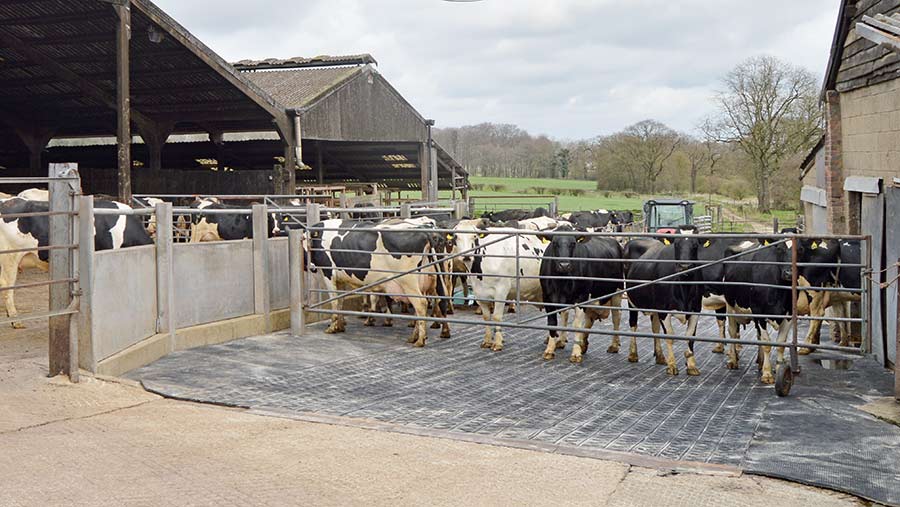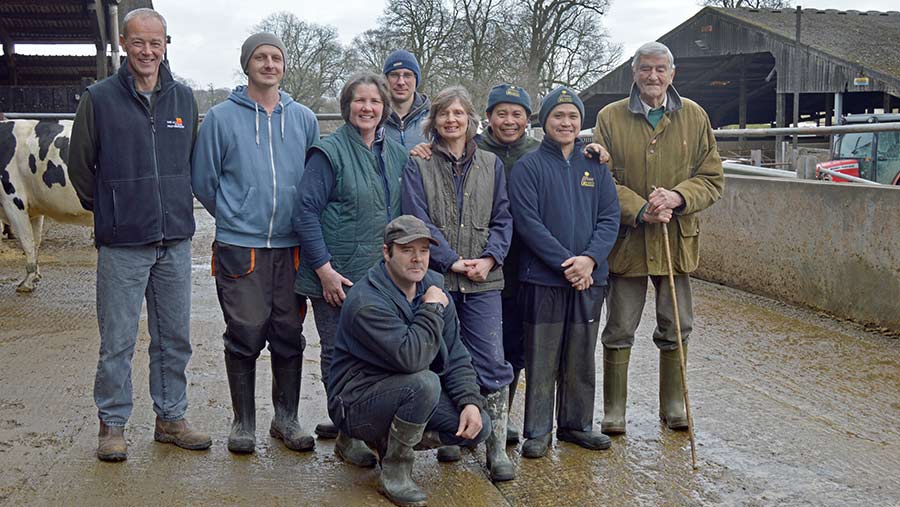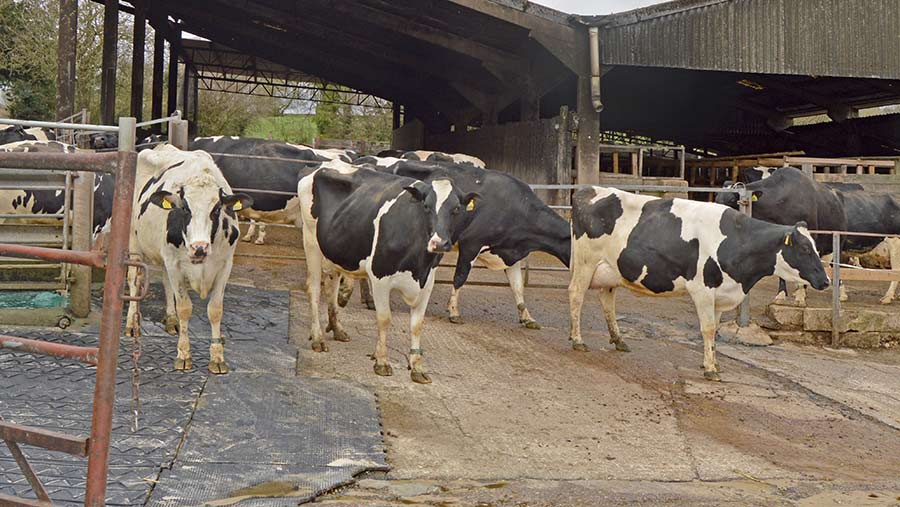How Hampshire dairy has climbed to top 5 for milk production

Consolidating cow numbers has helped one Hampshire herd shoot up 14 places in the NMR annual production report, to clinch fifth place.
In what was a tough year for dairy farmers across the UK, with a never-ending winter and scorching summer, the 280-head pedigree Holstein herd managed to lift production 391kg to 12,742kg a cow at 3.89% fat and 3.07% protein.
Farmer Joe Ives, who describes the system on the tenanted farm as labour-intensive and fairly low-tech, believes much of this achievement is due to attention to detail from his eight-strong team.
“I was surprised to hear that we had ranked in the top five of the report. We don’t have fancy buildings or a new farm, so I think it is good to show what can be achieved on a very normal farm,” he says.

Joe Ives and his eight-strong team
See also: Shropshire herd climbs to National Milk Records top spot
“It’s all about marginal gains and trying to get everything we do right. Everything you do, or don’t do, has a knock-on effect.
“We try to be in the top 5% of everything – the main thing is you have to make a profit.”
Joe’s father, Bill, who took on the tenancy in 1958 after being inspired to a career in agriculture by a stint in the country as an evacuee, says two things are key: breeding and feeding.
See also: 4 tips on improving lifetime daily yield in dairy cows
Farm facts: Park Farm, Basingstoke
- 244ha tenanted land on the Herriard Estate, Basingstoke (117ha grass, 53ha wheat, 74ha maize)
- Team of eight staff
- Arable business run alongside dairy by Bob Ives
- Pedigree Holstein herd, milked three times daily
- Surplus pedigree stock sold at market and privately
- Bull calves sold to Meadow Quality pre-42 days
- BVD and Johne’s-free
Destocking
One of the factors that allowed an increased attention to detail last year was a big drop in cow numbers.
By retaining surplus stock that would usually be sold, Joe had increased the herd to 400 head in 2016 to help spread the business’ costs across more cows when the milk price plummeted to 19p/litre.
Following two big sales at Sedgemoor auction market early last year, the herd was cut back to 280 in the milking herd, which Joe says undoubtedly helped them achieve the attention to detail and cow comfort that has contributed to high individual yields.
“At 400 cows, it was unsustainable with our buildings and took its toll on labour and the cows themselves,” says Joe.
“What we are trying to do is allow every cow to reach its potential.”
Joe credits four key areas of management for improving milk production:
Nutrition
Working closely with Mike Bray from Kite Consulting, the team have devised a simple nutrition plan based on just two total mixed rations (TMRs) – one for dry cows and one for the milking herd, with no concentrates fed.
The milking cows are fed TMR once a day, which comprises grass and maize silage, rapeseed meal, sugar beet, soya, caustic wheat, molasses, minerals, MegaLac and Bergafat. It is one-third grass and two-thirds maize. In total, they are aiming to feed 62kg of fresh matter at 44.9% DM.
The dry cow ration is based on well-chopped straw (to prevent sorting), maize silage and a dry cow blend.
“The dry cow ration has been brilliant,” says herd manager Sally Bowden. “We very rarely get the vet out to a calving – we don’t get problems like DAs [displaced abomasums] anymore.”
Bought-in feed costs total 8.01p/litre and to the end of February, margin over purchased feed (MOPF) was 20.85p/litre. Bill says MOPF has been a key measure to him ever since he had 20 cows, as it gives a good indication of what is available to pay all the other bills.
Grass is farmed in rotation with wheat and maize and Joe’s brother, Bob, and his son work in tandem with Joe on the arable side. Five- to six-year grass leys are grown alongside the permanent pasture.
Bill says Joe is “very particular” about silage quality, with quality grasses grown, and when it comes to cutting, they do it in the afternoon to keep sugars high, and focus on good consolidation and sealing the clamp well.
“I try to make sure every single bite that a cow takes is consistent,” says Joe.
Breeding and fertility
The Gladwake herd contains plenty of good cow families and top genetics. Through involvement in Hampshire Cattle Breeders Association, Bill travelled a lot in the 1980s and bought cow families with American genetics from Germany in the 1980s.
The herd contains several cows from the Primrose, Roxy and Darkeye families.
Joe employed Lilian Love last year and Mrs Love, who previously visited the farm as an AI technician, has been focusing on herd fertility.
The calving interval is 397 days and is still relatively high after having higher numbers of cows in the herd, says Joe. But cows are now getting in-calf quickly, with an average of 2.6 straws to conception.
Replacement heifers from the classified herd will have two to three goes with sexed semen before switching to conventional semen.
Conception rate is currently 65% at first service. For the past six months, sexed semen has also been used on a number of cows.
An Aberdeen Angus sweeper bull is used on anything that doesn’t hold to AI and beef calves are sold privately.
Perhaps surprisingly, given their NMR ranking, milk yield is not a factor when it comes to their mating programme. Bill explains: “The milk is there already – we want a cow that’s going to last.”
Longevity and fertility are paramount in the mating programme they run with Worldwide Sires, alongside type, udder and good legs and feet.
Joe is aiming to get six-plus lactations from cows or sell them as a good condition barrener.
Youngstock management
Last year was the first time hutch-reared heifers entered the milking herd.
Since making the switch to rearing calves in individual hutches in February 2016, health has significantly improved in the youngstock and growth rates have increased.
Also beneficial to health, Joe believes, has been the transition from computerised calf feeders to individual feeding. While it takes more time, he thinks moving away from the group system has reduced respiratory issues and disease build-up to a nominal level.
Mrs Love, who oversees youngstock management, has also switched milk powder, to Trouw Nutrition’s energised calf milk replacer, which she is pleased with.
“It is critical to get these calves off to a good start and not let them get knocked back,” says Mrs Love.
Youngstock are weaned at 70 days, providing they are eating 2.5kg of rearer nut and calf mix a day, and moved to a calf rearer, where they will graze for a season.
Joe values the scale when it comes to first service and won’t serve a heifer until she weighs 400kg.
“If they are too small, we can’t expect them to produce milk, grow and calve again,” he says.
Cow comfort and health
Reducing numbers allowed the team to get on top of any health issues with individual cows, allowing time to be devoted to body condition scoring and feet as a starting point.
Crucial to this is keeping milking time down, Mrs Bowden says. From leaving their shed to returning, cows only stand for about an hour during each milking and investment has been made in rubber matting in any standing areas to ease pressure on feet.
Last year, foot scores improved greatly, with more than 90% of the herd consistently scoring 0s and 1s.

In-house mobility scoring takes place monthly, foot-bathing takes place five days a week, and one of the team, Ric Mariano, looks after all foot-trimming.
The Park Farm team work in close partnership with their vet, Maarten Boers of the Livestock Partnership, and Mr Boers is in regular contact with Mike Bray on the nutrition side, so that cow management is fully aligned.
“Mastitis has always been our Achilles’ heel,” says Joe. However, this is something the team has worked hard to stay on top of through breeding and strict milking protocols.
“We now use selective dry cow therapy and our antibiotics use generally is less than half the dairy target set,” says Mrs Bowden. At the end of March, there had not been a mastitis case on the farm for three weeks.
She says the cows just don’t drop in milk production and she is regularly drying off cows giving 35 litres-plus.
The cows are run as four groups:
- The high-yielders
- Pregnant high-yielders
- Heifers
- Freshly calved cows
All groups, apart from the calving cows, are in sand-bedded cubicle housing at stocking rates of about 90%. The high-yielding group of 80 cows are in sheds that previously accommodated 130 cows; so they have plenty of space.
Joe says having plenty of the home-made wooden cubicles and ensuring there is plenty of feed space is important, because the sheds are old with narrow, blind alleyways, which need scraping three times daily.
The future
Despite their sudden climb to the top of the rankings, the Ives family don’t plan on standing still just yet.
They hope to invest in housing to improve cow comfort and reduce the need for cows to move between groups, and move away from feed bunkers to a central passageway to improve cow performance even further.
